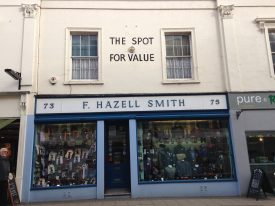One of the last shops to go in Leamington was Toytown, a much loved emporium, haunted by generations of children. It sold everything from Steiff Bears to pocket money toys. In Leamington, the main shopping street is called The Parade. It used to be occupied, like High Streets up and down the country, by small independent retailers, family firms which catered to the town’s people in a variety of different shops. It was a world where women went out each day, shopping basket at the ready, where groceries were delivered by boys on bicycles and people could buy goods on account.
A prosperous place
The town was a prosperous place. It had four department stores: Bobby’s, Woodward’s, E. Francis and Sons and Burgis & Colbourne. The only one that remains is what used to be Burgis & Colbourne – it’s now a House of Fraser. Burgis & Colbourne had a wonderful Food Hall, like a miniature Harrods, which smelt of ground coffee and smoked ham, where everything was weighed and packaged and which sold impossibly exotic things in Epicure tins, the kind of food one read about in books
My parents came from Leamington Spa and we would often come to the town to visit relatives and to shop. My mother had worked in Bobby’s and then Francis & Sons. She went into retail straight from school and stayed until she got married. Shop work was seen as a skilled occupation, a respectable job for a young woman and working in one of the department stores was a particularly sought after position. I have shared a picture of her, hair newly shingled, on the roof at Bobby’s with some of her co-workers. She went on from here to work at Francis & Sons in Millinery and Drapery, Fabrics and Haberdashery. She was a skilled dress maker, taking advantage of the latest patterns and the high quality fabrics to make most of her own clothes.
Burgis & Colbourne
When my mother’s younger brother left school, he went to work in Burgis & Colbourne’s furniture stores. Unlike my mother, he hated it. He left as soon as he could and went to Horticultural College because he couldn’t stand working indoors.
When I came to Leamington as a child in the ’50s and ’60s, the shops had hardly changed. They were all still there, the independent chemists, the boot and shoe maker, the tobacconist and the watchmaker, the bespoke tailor, the dairy and the milliner. The Parade was very like the High Street in Solihull (where we lived) but bigger and grander, although the shops were not as large or imposing as those on New Street and Corporation Street in nearby Birmingham. We would sometimes have lunch in the restaurant at Bobby’s. I remember thinking it was very grand and grown up with heavy silver cutlery, white linen napkins, the waitresses in black uniforms with aprons and caps.
A world that was about to change
It was a world that was about to change. Almost nothing remains of the town as it was then. Just a few ghostly reminders here and there: an old sign, painted high on a wall, advertising a shop which has long gone. Above street level, clocks mark the site of watchmakers’ or jewellers’ shops that are no longer there. A reminder of the passage of time, of how everything changes.
There is one shop that defies the age, that refuses to change. F. Hazell Smith, The Spot for Value, Gentlemen’s Outfitters, established over 85 years. Shops like this are survivals from a relatively recent past which disappeared suddenly and almost completely, like a retail die off. It is good to see a shop of the old fashioned kind, not as a museum exhibit but open for business in the middle of the town.
This is an abridged version of an entry originally published on the History Girls Blog, and is reproduced with permission of the author.
This piece is a response to the Through the Shop Window exhibition.











Comments
This article set me thinking of the shops we used to visit when out shopping with Mum in the early/mid 1960s, frighteningly now fifty odd years ago! As well as the slightly faded old fashioned grandeur of Burgis & Colbourne – and Francis’s or Bobby’s with the creaking floorboards, there was the Co-op on the corner of High Street and Wise Street. Here we used to order the coal and pay for the tokens we would put out for the milkman.
The was Bray’s the bakers, in Radford Road just around the corner from Althorpe Street, where we would buy the bread rolls, still warm from the oven. Back across Althorpe Street in High Street was ‘Bertie’ Winters sweet shop where you could often smell the dinner cooking as you bought your sweets.
Across the road, next to the Guards Inn, was the bakers where they had day old chicks in the window at Easter. There was the café Collette in Bath Street and the Spa Fancy Bakery in Hamilton Terrace where we used to buy, what were then called fairy cakes, but are now called cupcakes.
George Barr’s hardware shop in Clemens Street, Young’s the chemist in High Street, the Ladybird shop in Bath Place; Bunce’s the pork butchers in High Street, the list goes on.
All now gone, some killed off by competition from the new supermarkets but most closed when the (what seemed to a child) elderly owners retired. Shopkeepers that became more like friends – something the self service, self checkout supermarkets of today can never be.
Add a comment about this page